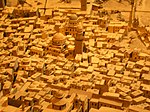The Western Wall Heritage Foundation
The Western Wall Heritage Foundation, often mentioned as the Western Wall Foundation, is the body responsible for administration for all matters concerning the Western Wall in Jerusalem. The group operates under the auspices of the office of the Prime Minister of Israel and the Government Companies Authority. Rabbi Ilan Cohen previously served as the Foundation's Chairman, and the position is currently held by Rabbi Shmuel Rabinovitch. The Western Wall Heritage Foundation was established in October 1988, for the purpose of general maintenance, development, supervision, excavation in the Western Wall Tunnels, maintaining the infrastructure of the Wall, exhibitions, and publicity. At a Cabinet meeting (19 December 2004), it was decided that the responsibilities of the Foundation would be extended to include all activities in the Western Wall Plaza and surrounding areas – building, maintenance (cleaning), development and educational projects. The latter activities include bringing specialized groups such as teenagers or soldiers for guided tours in the Old City and the Western Wall area.
Excerpt from the Wikipedia article The Western Wall Heritage Foundation (License: CC BY-SA 3.0, Authors).The Western Wall Heritage Foundation
Heil HaHandasa, Jerusalem Morasha
Geographical coordinates (GPS) Address Nearby Places Show on map
Geographical coordinates (GPS)
| Latitude | Longitude |
|---|---|
| N 31.776166666667 ° | E 35.232388888889 ° |
Address
העיר העתיקה
Heil HaHandasa
9511208 Jerusalem, Morasha
Jerusalem District, Israel
Open on Google Maps








